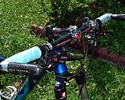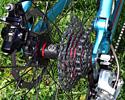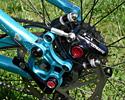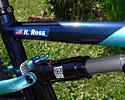
Recently on Cyclingnews.com |
Pro bikes, August 16, 2007
Nat Ross' Subaru-Gary Fisher Gary Fisher HiFi 29
Rollin' on twenty-ninesByJames Huang Twenty-four-hour endurance racing is a burgeoning segment of the competitive mountain bike scene on both the amateur and professional fronts, but Nat Ross is still among a select few who have managed to achieve true notoriety as a specialist in the discipline. 2007 will mark the Subaru-Gary Fisher veteran's seventh season with the team, racking up the 2006 US 24 Hour Solo National Series championship and winning the 24 Hours of Moab, Landahl, and Temecula in the process, along with numerous podium finishes throughout his career. "I've been doing these races since '98 and I'm on my 33rd or 34th 24 hour solo race," said Ross. "The coolest thing for me now is to explore new venues, do new races, and get some different experiences other than the same loop year after year." Naturally, the distinctive environment of 24-hour solo racing places unique demands on both rider and equipment, some of which would rarely be found in a typical shorter format XC event. First and foremost, Ross was one of the earliest in the pro ranks to adopt the 29" wheel standard exclusively for all of his events. Although somewhat heavier than the 26" standard, its other advantages far outweigh that drawback, at least for Ross. Interestingly, however, one of the 29" wheel's most heavily referenced advantage is not one that is particularly key for him. "Typically, a lot of the 24hr hour courses aren't very technically demanding so it's not like the advantages of a 29" wheel shine, but it softens the ride, first and foremost, it gives you superior traction, and floatability. So let's say, in Moab, when I'm out there riding 23 laps on the sand, I can float across and ride through all the sandpits." Ross was one of the earliest recipients of Gary Fisher's new HiFi 29, a full-suspension machine based on the company's successful 26" HiFi but adapted around the larger hoops. The new frame retains the heavily butted and swaged hydroformed tubing, updated faux-bar rear suspension system, 'Wide Stance' main pivot, and asymmetrical swingarm, but the carbon fiber seat stays of the original has been swapped for aluminum ones on the 29" version. The head tube length is kept noticeably short to maintain a reasonable bar height, and also houses an internal headset for the same reason. The new frame aside, Ross is perhaps most excited about Bontrager's newly introduced tubeless 29" wheel and tire options. "The two-nine tubeless compatible system is, for me, something I've been waiting for, and waiting for, and waiting for," said Ross. "I've always made my own at home, and I've had blowouts. You've had incompatibilities with the hoop, the diameter of the tires, and running a sponsor-specific tire, it was always a big challenge for me. I felt like it was my only handicap out there, trying to have a light tubeless tire. Now that I have it, I can ride, I can open it up on downhills and I don't have to be hesitant. The 29er tire choices are insane right now; you've got the eight companies out there just making a vast selection of width and racing tires, fat tires, freeride tires, all that stuff for 29er now." Lighting is another endurance racing-specific aspect of equipment, and Ross is a devotee of current HID systems instead of jumping on the currently-hot LED technology. "I do the Light&Motion ARC Li-ion HID system. I've found that they last the longest, they're the brightest, and they're really light. I always do a helmet-mounted light so that I can look at my gear choices, look at the trail, upcoming hills, corners, and all that, and I do another Light & Motion HID on the handlebars. I run those for two hours and then switch the batteries out. I want to make sure my batteries are always fresh, and that I have at least another 45-55 minutes of extra juice just in case something happens or I have to run a lap in." At 12.7kg (28.1lb), Ross' HiFi 29 isn't likely to win any weight contests, but component selections are clearly made more in the interest of dependable performance over the long haul without adding too many grams; lighter parts might save Ross a few minutes, but an ill-timed or particularly dramatic failure can cost far more. According to Ross, "You're using a lot more sealant, you're using beefier, heavier tires, you're compromising on the weight and going with stability or just a bulletproof system where you're carrying the minimal amount of supplies out there yet you have everything you need… for the most part, everything is just a little bit beefier than a cross-country setup. You may be changing your setup during the middle of the night when you're fatigued, and you don't want to be without equipment out there at the darkest hours." Included in Ross' security blanket is a seat pack (a virtually unheard-of accessory in usual XC events) housing an extra tube, air canisters, chain tool and spare links, tire lever, and patch kit (?!). Obviously, ultimate success in endurance racing is primarily dependent on the rider, but Ross certainly doesn't make any illusion as to the importance of race support and pre-race preparation. It's a misnomer that it's called 'solo' because it takes the mechanic, a support crew, someone to help you out with your lighting and whatnot. There comes a lot more behind-the-scenes preparation," he said. "I think to be a successful racer nowadays requires a minimum of two bikes and extra wheelsets where in the past you could kind of just support yourself. It's most important that you put the time in to preparing for the races, not necessarily just the training but that you show up early, that you've got your bikes dialed, that you've gone through the course, that you've got a backup plan, perhaps that you've gone over stuff with your crew, you've got your nutritional needs outlined, and then it's very nice to have support, like a mechanic, out there. Sometimes I bring along a friend if it's a far away race, or if I'm lucky, I can have our team mechanic there at select races. At certain races you might also get the Trek trailer which is even better because you might get the manager, John Rourke, there, you might have other teammates out there and it's more of a party or festival scene, which is the reason I started doing this in the first place." So what does the future hold for Ross? Looking forward, Ross wants "to continue to race for another four years and remain where I am right now in the standings with being able to stay competitive, set course records if necessary, go overseas and race over there on their turf, and while they're figuring out the scene still because it's only a matter of years before we get passed in all of our results and the way that we ride. The sport's going to change once the 24hr racing or endurance as we know it beyond the stage races blows up over there. It's already starting to. PhotographyFor a thumbnail gallery of these images, click here Images by James Huang/Cyclingnews.com
| |||||
Full specificationFrame: Gary Fisher HiFi 29 Critical measurements Bottom bracket: Bontrager Race X Lite GXP |
Wheelset: Bontrager Race X Lite Disc 29 Bars: Bontrager Race XXX Lite, 610mm Pedals: Crank Brothers Candy 4Ti Total bike weight: 12.7kg (28.1lb) | ||||










